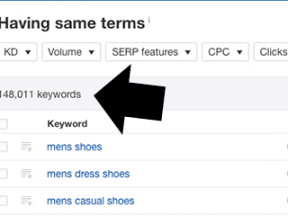Search engine optimization hinges on content relevance. No relevance means no rankings and no revenue from natural search. Follow these seven SEO tips to ensure that your site is optimized for the most valuable set of keywords to drive natural search performance.
7 Tips to Optimize Content
Research keyword themes. Keyword research-powered knowledge of searchers’ desires should guide your natural search strategy, as well as inform the content strategy for the entire site. Use keyword research to analyze where there might be gaps in your site that need to be filled with fresh content. As you’re analyzing, assign intent to keyword themes — purchase, information, or pure navigational intent — to ensure that the right content is created to fulfill the desire implied by each theme.
Make sure that your keyword research is refreshed regularly — not less than annually, quarterly is best.
Make sure that your keyword research is refreshed regularly…
Remove self-competition. Map keyword themes to specific pages to ensure that as many relevant keywords as possible have a place on your site. This removes the natural tendency to try to optimize every page for a similar set of high-demand keywords.
Keyword mapping is especially beneficial on a site with a distributed SEO model, in which multiple departments manage their own optimization. Try to organize keyword mapping centrally so the departments aren’t battling for rankings on pages that are only semi-relevant for a high-demand theme.
Optimize editorial processes. Content optimization becomes much easier if SEO is incorporated before the content is created. Include SEO in editorial meetings to share keyword research that can generate new ideas for the content calendar, as well as guide the individual themes of content pieces.
The intent is to participate, not to dictate. Editorial creativity is critical to developing content that people want to engage with. So-called “SEO content” — text that is written solely to target keywords — is painful to read, doesn’t result in engagement, and fails to drive SEO performance.
Optimize scalably. Programmatic optimization — using default “formulas” to generate title tags, meta descriptions, headings, image alt attributes — is the most efficient way to improve tag-based content on the site. It requires developer intervention, but the result is more strongly optimized content across every page of the site.
Product detail pages contain interesting possibilities when it comes to scalable optimization. Product management tools contain a staggering array of data that could be used to create bulleted lists of product attributes or even rudimentary supporting copy on pages to benefit shoppers as well as bolster SEO performance.
For example, a list of the available materials, colors, finishes, sizes, styles, and other attributes could be included in the product detail page.
Programmatic optimization … is the most efficient way to improve tag-based content on the site.
Optimize manually. A formula can only take you so far. The pages that represent the highest value keyword themes require manual optimization to fine-tune. Title tags and meta descriptions are the typical targets for manual tweaks.
Optimizing titles is usually more about fixing awkward grammar introduced by formulas. For example, the same formula that generates “Women’s Watches” and “Women’s Shoes” as headings by mashing together gender and category names might also create “Women’s Other Accessories.” These are typically edge cases and easily identified for manual optimization by crawling the site.
The main body of text on a page should always be manually optimized — scalable optimization techniques can’t be applied to creatively written content.
Monitor optimization metrics. Use Google Search Console or a crawl report to identify duplicate or missing content elements on the site. For example, a poorly optimized site might have the title tag “Product Page” on every product page. That doesn’t speak to the unique relevance that each page offers, and results in search engines passing over the site for others that are more uniquely optimized.
Manually optimize the duplicate title tags and meta descriptions so that they communicate the unique relevance for that page. If every page contains duplicate title tags and meta descriptions, and your site is large, start with the scalable optimization method before moving to manual to drive performance more quickly.
Optimize digital assets. Lastly, make sure to optimize the images and videos on the site. Images should not contain textual content. If an image contains text, it should be floated over a background image using CSS so that search engines can crawl and index the content. The image’s alt attribute can then be blank — the floating text says it all.
Videos are similarly impenetrable to search engines. The audio may have a transcript, which is crawlable, but the visuals are still a problem when conveying relevance to search engines. Each video file that you want to rank should have its own page.
That page should contain a summary of the video, a transcript, and be marked up with structured data from the VideoObject and CreativeWork schema by Schema.org. There’s a lot more to video optimization than just these elements. But it’s a start.




